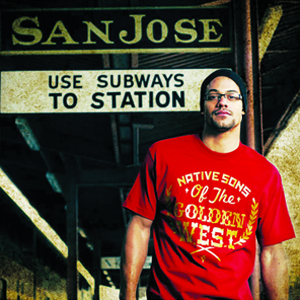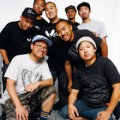When one thinks of combining tribal tattoos and clothing, what usually springs to mind are roided-out MMA fighters in Tapout tops or L.A.-trash brands like Ed Hardy.
But Cukui Clothing Company, the latest addition to San Jose’s Japantown, takes a whole different spin on merging body-art-inspired designs and garments. Skulls, cherries, fleurs-de-lis and flash art this is not—Cukui takes its original tattoo designs seriously.
As the self-proclaimed street wear brainchild of “a bunch of Chicanos, South Pacific Islanders, tattooers and graff heads,” Cukui opened on Aug. 13, and is already having trouble keeping up with demand.
In an era when most mom-and-pop clothing companies are shaking in their boots trying to stay in business, Cukui CEO and head designer Orly Locquiao says that he’s planning on expanding his brand from screen-printed T-shirts and urban wear to watches, belts, hats, accessories and women’s wear.
Part of the thanks has to go to Locquiao himself. As one of the most celebrated Polynesian tribal-style tattoo artists in the South Bay, he has a well-trained eye for blending the contemporary and the traditional. Locquiao is constantly challenged to come up with new and interesting designs at what he calls his “day job” at Humble Beginnings Tattoo Studio on West San Carlos.
“My daily inspiration is the tattoo shop, being here, and always, constantly drawing for the clients,” 34-year-old Locquiao says. “If somebody gives a good idea for a tattoo design, then sometimes I’ll want to implement that onto a T-shirt and fuse those two together.”
With the help of his co-graphic designer Samuel Rodriguez, his wife, Michelle, and brother Jason, Locquiao aims to start a new genre in San Jose art and urban wear with Cukui. Locquiao got his training in traditional Polynesian tribal aesthetics and tattooing techniques in Hawaii, which he calls his “second home.”
Nowadays, though, he prefers a modern steel tattoo gun or pen and paper to the soot, oil and hammering sticks of the traditional methods of transferring art onto bare skin.
“Every old culture has a certain tribal, from Celtic to Aztec to the Pacific islands and Indians,” he says. “Everything has a relation. There are patterns from old European tribal that match up to New Zealand tribal, and there’s Hawaiian tribal that looks just like Aztec tribal. They are simple shapes, simple forms, and they have almost the same meanings in some respects.”
After eight years in business as a tattooer, Locquiao says coming up with unique, original designs for the Cukui brand offers him an artistic freedom he didn’t have before. It’s a big relief not to have to worry about how the image will appear on someone’s sun-damaged thigh 20 years down the road.
“The technique for tattooing is more strict because it’s long-term,” he says. “You’ve got to realize that you’re tattooing on skin. Skin flexes, skin moves, and you fluctuate in weight. So, you can’t put the lines superclose together, or they’ll end up bleeding together, while on a T-shirt design, you can do almost anything you want. “
The brand name “Cukui” goes back to Locquiao’s mixed island and NorCal roots, as well as his tattoo-artist preference for symbolism. In Hawaii, “Kukui” is a candlenut, a large brown fruit used in island cuisine. The candlenut tree is traditionally seen as a bringer of enlightenment, protection and peace, as well as the body-form of the Polynesian pig-god Kamapua’a. In the Mexican-American community, “El Cucuy” is a fairy tale creature that’s said to eat children who misbehave when they are told to go to bed.
With its ultramodern stone-moss-blond-wood interior, Cukui’s minimalist shop at 229 Jackson St. was thought through with a careful eye to aesthetics. One of Cukui’s coolest features has to be its small-batch-clothing approach. Instead of coming out with new T-shirt only two or three times a year like most fashion designers, Locquiao debuts a handful of new T-shirt designs a month. This way, customers are guaranteed to see something different every time they stop by the shop.
“It’s almost like a new minicollection every month,” Locquiao explains. “We come out with something new and fresh, and then we’ll do a small run, like 36 pieces in, to see if the community likes it. That’s the good thing about constantly producing new imagery, and new designs, is that you really get to cater to everybody.”




